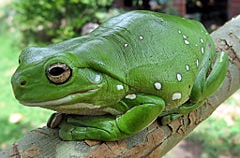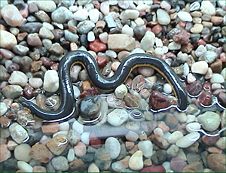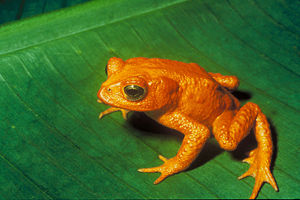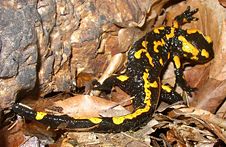Amphibian
- For other uses, see Amphibian (disambiguation).
| Amphibians | ||||||||
|---|---|---|---|---|---|---|---|---|
 White's Tree Frog (Litoria caerulea) | ||||||||
| Scientific classification | ||||||||
| ||||||||
| Orders | ||||||||
|
Subclass Labyrinthodontia - extinct |
Amphibians (class Amphibia) are a taxon of animals that include all tetrapods (four-legged vertebrates) that do not have amniotic eggs. Amphibians (from Greek αμφις "both" and βιος "life") generally spend part of their time on land, but they do not have the adaptations to an entirely terrestrial existence found in most other modern tetrapods (amniotes). There are about 5,950 described, living species of amphibians. The study of amphibians and reptiles is known as herpetology.
History of amphibians
Amphibians developed with the characteristics of pharyngeal slits/gills, a dorsal nerve cord, a notochord, and a post-anal tail at different stages of their life. They have persisted since the dawn of tetrapods 390 million years ago in the Devonian period, when they were the first four-legged animals to develop lungs. During the following Carboniferous period they also developed the ability to walk on land to avoid aquatic competition and predation while allowing them to travel from water source to water source. As a group they maintained the status of the dominant animal for nearly 75 million years. Throughout their history they have ranged in size from the 3 foot (90cm) long Devonian Ichthyostega, to the slightly larger 5 foot (150cm) long Permian Eryops, and down to the tiny Brachycephalus didactylus (Brazilian Gold Frog) and Eleutherodactylus iberia from Cuba, with a total length of 9.6-9.8 millimeters (0.4 inches). Amphibians have mastered almost every climate on earth from the hottest deserts to the frozen arctic.
Classification

Traditionally the amphibians are taken to include all tetrapods that are not amniotes. Recent amphibians all belong to a single subgroup of these, called the Lissamphibia. Recently there has been a tendency to restrict the class Amphibia to the Lissamphibia, i.e. to exclude tetrapods that are not more closely related to modern forms than they are to modern reptiles, birds, and mammals.
There are two ancient, extinct, subclasses:
- Subclass Labyrinthodontia (paraphyletic)
- Subclass Lepospondyli
Of the remaining modern subclass Lissamphibia there are three orders:
- Order Anura (frogs and toads) (in Superorder Salientia): 5,228 species
- Order Caudata or Urodela (salamanders): 552 species
- Order Gymnophiona or Apoda (caecilians): 171 species
Authorities disagree on whether Salientia is a Superorder that includes the order Anura, or whether Anura is a sub-order of the order Salientia. In effect Salientia includes all the Anura plus a single Triassic proto-frog species, Triadobatrachus massinoti. Practical considerations seem to favour using the former arrangement now.
Reproduction
For the purpose of reproduction most amphibians are bound to fresh water. A few tolerate brackish water, but there are no true sea water amphibians. Several hundred frog species in adaptive radiations (e.g., Eleutherodactylus, the Pacific Platymantines, the Australo-Papuan microhylids, and many other tropical frogs), however, do not need any water whatsoever. They reproduce via direct development, an ecological and evolutionary adaptation that has allowed them to be completely independent from free-standing water. Almost all of these frogs live in wet tropical rainforests and their eggs hatch directly into miniature versions of the adult, bypassing the tadpole stage entirely. Several species have also adapted to arid and semi-arid environments, but most of them still need water to lay their eggs. Symbiosis with single celled algae that lives in the jelly-like layer of the eggs has evolved several times. The larvae (tadpoles or polliwogs) breathe with exterior gills. After hatching, they start to transform gradually into the adult's appearance. This process is called metamorphosis. Typically, the animals then leave the water and become terrestrial adults, but there are many interesting exceptions to this general way of reproduction.
The most obvious part of the amphibian metamorphosis is the formation of four legs in order to support the body on land. But there are several other changes:
- The gills are replaced by other respiratory organs, i.e. lungs.
- The skin changes and develops glands to avoid dehydration
- The eyes get eyelids and adapt to vision outside the water
- An eardrum is developed to lock the middle ear
- In frogs and toads, the tail disappears
Amphibian conservation

Dramatic declines in amphibian populations, including population crashes and mass localized extinction, have been noted in the past two decades from locations all over the world, and amphibian declines are thus perceived as one of the most critical threats to global biodiversity. A number of causes are believed to be involved, including habitat destruction and modification, over-exploitation, pollution, introduced species, climate change, and disease. However, many of the causes of amphibian declines are still poorly understood, and amphibian declines are currently a topic of much ongoing research.
See also
- Frog zoology
- Prehistoric amphibian
- Tetrapod
ReferencesISBN links support NWE through referral fees
- Duellman/Trueb, Biology of Amphibians
- Pounds, J. Alan and Martín R. Bustamante, Luis A. Coloma, Jamie A. Consuegra, Michael P. L. Fogden, Pru N. Foster, Enrique La Marca, Karen L. Masters, Andrés Merino-Viteri, Robert Puschendorf, Santiago R. Ron, G. Arturo Sánchez-Azofeifa, Christopher J. Still and Bruce E. Young (January 2006). Widespread amphibian extinctions from epidemic disease driven by global warming. Nature 439: 161-167. Digital object identifier (DOI): 10.1038/nature04246.
- Solomon Berg Martin, Biology
- Stuart, Simon N. and Janice S. Chanson, Neil A. Cox, Bruce E. Young, Ana S. L. Rodrigues, Debra L. Fischman, Robert W. Waller (December 2004). Status and trends of amphibian declines and extinctions worldwide. Science 306 (5702): 1783-1786. Digital object identifier (DOI): 10.1126/science.1103538.
External links
- American Museum of Natural History: Department of herpetology
- The Global Amphibian Assessment
- AmphibiaWeb
Credits
New World Encyclopedia writers and editors rewrote and completed the Wikipedia article in accordance with New World Encyclopedia standards. This article abides by terms of the Creative Commons CC-by-sa 3.0 License (CC-by-sa), which may be used and disseminated with proper attribution. Credit is due under the terms of this license that can reference both the New World Encyclopedia contributors and the selfless volunteer contributors of the Wikimedia Foundation. To cite this article click here for a list of acceptable citing formats.The history of earlier contributions by wikipedians is accessible to researchers here:
The history of this article since it was imported to New World Encyclopedia:
Note: Some restrictions may apply to use of individual images which are separately licensed.


